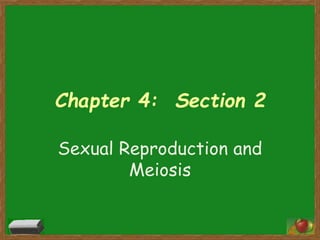
Chapter 4 section 2 notes
- 1. Chapter 4: Section 2 Sexual Reproduction and Meiosis
- 2. II. Sexual Reproduction A. Introduction to Sexual Reproduction 1. In sexual reproduction, a new organism is produced when sex cells from two parents combine. a. Each sex cell is produced by a different parent. 1. Sperm are sex cells produced by the male parent. a. Sperm are usually small with whiplike tails. 2. Eggs are sex cells produced by the female parent. a. Eggs are usually large and contain food material. 2
- 3. B. Production of Sex Cells 1. Human body cells have 23 pairs of chromosomes, but human sex cells have only 23 total chromosomes. 2. The process of nuclear division that produces sex cells is called Meiosis. a. Meiosis takes place in cells of reproductive organs in both plants and animals. 3
- 4. C. Importance of Sex Cells 1. In body cells, chromosomes are found in pairs. a. A cell that has two of every kind of chromosome is said to be diploid. b. Diploid is written as 2n in Biology. 2. Sex cells contain only one chromosome from each matched pair. a. A cell that contains only one chromosome is said to be haploid. b. Haploid is written as 1n in Biology. 4
- 5. Haploid Cells Diploid Cells 5
- 6. D. Comparing Haploid and Diploid Cells 1. A human body cell is considered diploid. a. Human body cells contain 23 pairs of chromosomes. 2. A human sex cell is considered to be haploid. a. A human sex cell contains 23 total chromosomes. 6
- 7. E. Fertilization 1. Sexual reproduction starts with the formation of sex cells and ends when one sex cell joins with another; a new organism is formed. 7
- 8. E. Fertilization 2. The joining of an egg and a sperm is called fertilization. a. The cell that forms in fertilization is called a zygote. b. If an egg (1n) with 23 chromosomes joins with a sperm (1n) that has 23 chromosomes, a zygote forms that has 46 chromosomes. 1. The zygote is considered to be diploid. (2n) 8
- 9. 9
- 10. F. Chromosomes in Species 1. Each species has a fixed number of chromosomes. a. Humans have 46 chromosomes. b. A donkey has 66 chromosomes. c. A horse has 60 chromosomes. 10
- 11. III. Meiosis A. Introduction to Meiosis 1. In Meiosis, there are two divisions of the nucleus, Meiosis I and Meiosis II. a. Mitosis only has one division!!! 2. Meiosis deals only with sex cells. a. Sperm and Egg 11
- 12. Diagram of Meiosis I 12
- 13. III. Meiosis B. Meiosis I 1. Interphase 1: Cells undergo a round of DNA replication, forming duplicate chromosomes. 2. Prophase 1: a. Double stranded chromosomes and spindle fibers appear. b. The nuclear membrane and nucleolus disappear. c. Like chromosomes come together in matching pairs to form a TETRAD. 13
- 14. III. Meiosis B. Meiosis I 3. Metaphase 1 a. Pairs of chromosomes line up in the center of the cell. b. Centromeres become attached to the spindle fibers. 4. Anaphase 1 a. The spindle fibers pull the homologous (like chromosomes) toward opposite ends of the cell. 14
- 15. III. Meiosis B. Meiosis I 5. Telophase 1 a. The cytoplasm divides and two cells form. b. Each chromosome is still double stranded!! 15
- 16. Diagram of Meiosis II 16
- 17. III. Meiosis C. Meiosis II (follows Meiosis I) 1. Prophase 2 a. The double stranded chromosomes and spindle fibers reappear in each new cell. 2. Metaphase 2 a. The double stranded chromosomes move to the center of the cell. b. Centromeres attach to the spindle fibers. 17
- 18. III. Meiosis C. Meiosis II (follows Meiosis I) 3. Anaphase 2 a. The centromere divides, and two strands of each chromosome separate and move to opposite ends of the cell. 18
- 19. III. Meiosis C. Meiosis II (follows Meiosis I) 4. Telophase 2 a. The spindle fibers disappear, and a nuclear membrane forms around the chromosomes at each end of the cell. b. Each nucleus contains only half the number of chromosomes that were in the original nucleus. 19
- 20. Meiosis I and Meiosis II 20
- 21. III. Meiosis D. Facts about Meiosis 1. A cell with 46 chromosomes at the beginning of Meiosis 1 divides to produce cells that each only have 23 single stranded chromosomes at the end of Meiosis 2. 21
- 22. 22
- 23. III. Meiosis E. Mistakes in Meiosis 1. Mistakes are more common in plants than animals. 2. Mistakes can produce sex cells with too few or too many chromosomes. a. Sometimes, zygotes produced from these sex cells die. b. If the zygote lives, the organism may not grow normally because cells will have the wrong number of chromosomes. 23
- 24. III. Meiosis 24